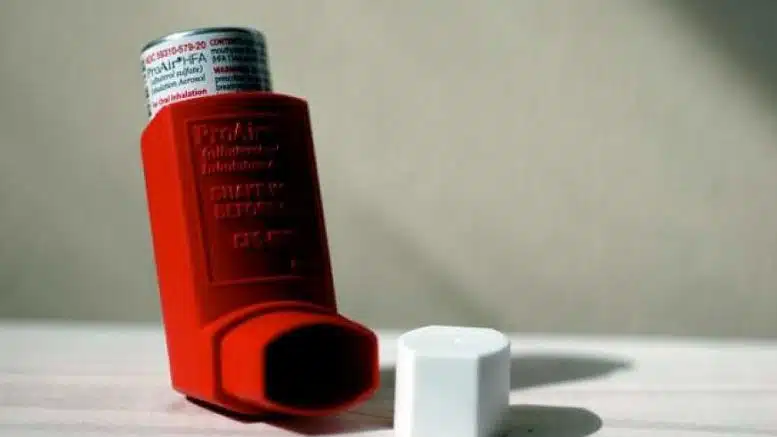By Will Atwater
September is an exciting time for many, as summer’s long, hot days begin to give way to cooler temperatures and fall colors. Primary school and college students return to classes, and crowds pack high school bleachers and college stadiums on Friday nights and Saturday afternoons to cheer on their favorite fall sports teams, among other fun autumn activities.
However, for children and communities of color — especially Black Americans — experts suggest grabbing an inhaler before heading out to enjoy seasonal pastimes.
These groups are more susceptible to asthma than their white peers, and September is known as asthma peak month, with the third week considered to be the peak week.
Kids returning to school and seasonal allergies contribute to the spike in asthma rates at this time of year.
“The kids are getting back together. They’re swapping cold viruses, and we know that cold viruses are the most common trigger for asthma flares,” said Allison Burbank, assistant professor of pediatric allergy and immunology at the UNC School of Medicine.
“The weed pollens like ragweed are sort of peaking around this time,” she continued. “And so people with weed pollen allergies are set up for this double hit — with this high load of allergens they are getting exposed to and then, on top of that, the respiratory viruses.”
And then there’s mold, which develops outside as the weather gets cooler and damper. Inside mold is an issue, too, and sometimes schools are the culprits.
For instance, in August, the Alamance-Burlington School System announced that it would delay opening because of mold found at several district schools.
Gina Carroll, lead elementary school nurse for the district, said it’s too early to know whether any health-related issues will arise from the mold. She is confident the mold removal process was thorough.
“As a district, we put in a lot of work and are putting in a lot of preventative measures to hopefully not deal with it as an issue again,” she said. Parents of children with or without asthma should consult their family doctor if their children experience respiratory problems, she added.
Melissa Lassen, Chatham County Schools’ lead nurse, said that of the 9,300 students enrolled in the district, 8 percent to 10 percent have asthma. She also noted that the number of affected children may change over time.
“A child may have kept an inhaler at school all through their elementary school years […] Some students, as they move into older grades, will tend to see their asthma symptoms improve.”
NC Health News has reported on the role that school nurses play in keeping children healthy — especially at the beginning of the school year when seasonal allergies and cooler temperatures kick in.
Stavros Garantziotis, a medical director at the National Institute of Environmental Health Sciences, agrees that September can be challenging for people with asthma.
“For children, 25 percent of asthma-related hospital stays occur in September,” he said. “The reason is probably exposure to viral infections that spread rapidly in schools […], and other asthma triggers like mold, pollen and pests that are more common in crowded places like schools. And the kids can also bring them home on their clothes.”
‘It’s dynamic’
Asthma is a chronic disease affecting nearly 25 million Americans, including roughly 5 million children. According to the most recent data from the Centers for Disease Control and Prevention, 717,344 people, or 8.7 percent of North Carolinians have been diagnosed with asthma.
The American Thoracic Society published a report in 2018, stating that asthma costs the U.S. economy “$80 billion annually in lost work and school days, medical expenses and deaths.”
Symptoms include narrowing of the airways, which is caused by inflammation, making it difficult for oxygen to travel to the lungs. It leads to mucus buildup, wheezing, coughing and shortness of breath.
Unlike many chronic diseases, “asthma symptoms are not always persistent,” Garantziotis said.
“If you have asthma, you can be perfectly fine one day and really sick the next day,” Garantziotis said. “That’s what you’re looking for when you’re trying to see if somebody has asthma, if they have wheezing or cough and shortness of breath that can vary between days. It’s dynamic, as we call it.”
Unequal distribution
The CDC reports that 1 in 13 Americans have asthma. However, Black people and other communities of color have higher rates of asthma than their white peers. The CDC reports that for Black people and non-Hispanic white people:
- From 2016 to 2018, Black people visited emergency rooms/urgent care centers twice as often as white people.
- In 2021, Black people’s asthma rates were 1.5 times greater than white people’s.
- Black people are twice as likely to have a hospital stay due to asthma.
- Black people are nearly three times more likely to die from asthma.
- Black children are roughly eight times more likely to die from asthma.
The National Heart, Lung, and Blood Institute reports that 11 percent of Black Americans, 10 percent of American Indians/Alaska Natives, 8 percent of white Americans and 6 percent of Hispanics/Latinos have asthma.
Further, the Asthma and Allergy Foundation of America includes four categories to consider when examining asthma disparities. Those are:
- Structural: racism, segregation and discriminatory policies.
- Social: income, physical environment, access to health care.
- Biological: family history, genetic disposition.
- Behavioral: tobacco use, proper use of medicines.
Many members of communities of color, such as Black people, live in urban and rural communities, where environmental issues can affect health. Under-resourced urban and rural areas often experience poor air quality days because of their close proximity to highways, industry, landfills and agriculture.
More complications
Climate change is another pressing environmental issue threatening to increase poor air quality days. Earlier this summer, smoke from the Canadian wildfires blanketed a large section of the East Coast. According to reports, hazy skies reached from New England as far south as the Carolinas.
“Climate change and air pollution are the two major global public health challenges,” said Kirsten Minor, health manager at CleanAIRE NC, a Charlotte-based clean air advocacy organization. “Every year, more than 3 million people [worldwide] die from air pollution diseases.”
Experts warn that increased poor air quality days, longer allergy seasons and a proliferation of mold, among other asthma triggers, could intensify as the planet becomes warmer and the weather more turbulent.
Additionally, “patients with pre-existing respiratory diseases are potentially at increased risk of adverse effects of ozone exposure,” according to a report by the CDC. Bad ozone days cause people with asthma to experience decreased lung function, more need for medication and doctor visits, and increased respiratory issues and asthma flare-ups.
CleanAIRE NC is also concerned about ground-level ozone and its effects on public health. In a release published on Sept. 7, the organization was disappointed that the Environmental Protection Agency delayed setting “stronger air quality standards for ground-level ozone (O3), also known as smog.”
“Ozone is a dangerous pollutant that can severely damage our lungs and trigger asthma attacks, increase hospitalizations, and even result in premature death,” the release states in part. “Nine of the 10 leading causes of death in North Carolina are caused or exacerbated by ozone exposure, including stroke, COVID-19, heart disease, and respiratory illnesses.”
‘Putting out a fire’ vs. ‘fire prevention’
In December, NC Health News reported that CleanAIRE NC is working with Sampson County residents to establish an air quality monitoring program. They are partnering with residents and other organizations to develop a “citizen scientists” team with the tools and knowledge to collect air quality data, alerting them to potential problems that can be documented and shared with neighbors and local, state and federal officials.
For more information about the program, email CleanAIRE NC at [email protected] or call them at 704-307-9528.
Those with asthma may qualify to join a longitudinal study led by Garantziotis through the National Institute of Environmental Health Sciences. NIEHS’ asthma program eligibility requirements are listed here: https://joinastudy.niehs.nih.gov/studies/nhales.
“Unfortunately, Black Americans are underrepresented in terms of medical coverage and more likely to use the emergency room for asthma care,” Garantziotis said. “The emergency room is not there to control something major. It’s there to put out a fire.”
He went on to say that one shouldn’t wait to have a fire in their house. Instead, they should establish a treatment plan with a health care provider to control asthma symptoms, which is the “difference between fire prevention and putting out the fire.”








